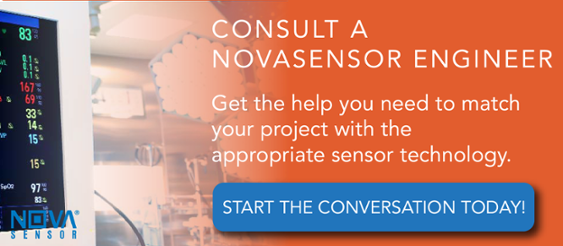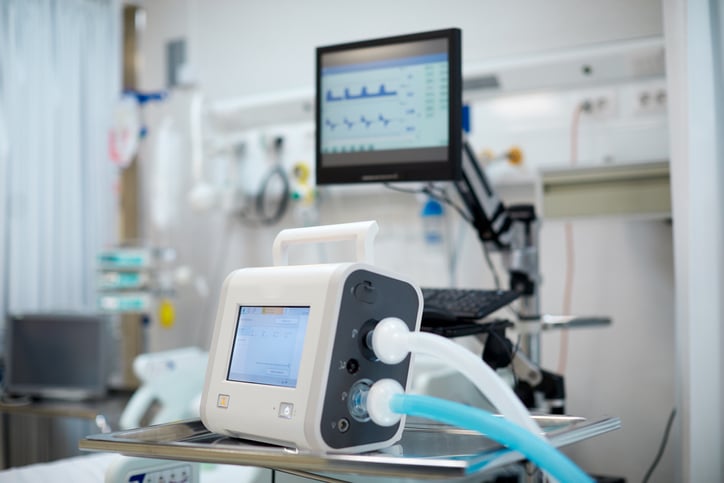Patient Monitoring Sensors: Custom vs. Generic Sensor Solutions

After months of R&D, multiple prototypes, and a few discarded ideas, you've finalized the design for a patient care device and completed the medical instrument design. Now, there's just one more component to consider: the sensor technology for the medical equipment.
This is a decision that every OEM medical device design team must confront. Essentially, the choice is between off-the-shelf patient monitoring sensors or a custom-made one.
For any OEM medical equipment, the sensors should be the last thing your team needs to worry about. You shouldn't have to lose sleep over patient monitoring sensors compromising performance or causing user frustration.
While both types of sensors can handle basic functions, their differences in functionality and durability can significantly impact your medical device's overall performance – and consequently, user satisfaction and patient outcomes.
Patient Monitoring Sensors for Medical Devices: A Closer Look
When it comes to adding sensor technology to the design and development of medical electronic instrumentation, you have two choices: use a ready-made generic sensor or a custom sensor.
Let’s take a look at option #1.
Ready-made generic sensors are among the most common sensor technology on the market.
Why?
As their name implies, they’re designed and manufactured to meet a variety of purposes and performance requirements. They're also practically immediately available. In a sense, they’re no different than aftermarket parts for a vehicle.
Option #2 on the other hand, custom sensors are tailored to the demands of application, delivering more accurate readings and better performance.
And because they’re made for a specific purpose, custom sensor technology is also able to stand up to the rigors of use without compromising accuracy or reliability.
Certainly, ready-made sensors have their place. OEMs of all sorts use them every day for their devices. However, generic sensors have one major shortfall: they simply aren’t designed for your specific application. And that means the sensor type opens the doors to a range of issues for your product:
- Fit
- Performance
- Environment
- Lifespan
1. Fit
Generic Sensors – As the adage goes, a square peg doesn’t fit in a round hole. When not designed to your device, it's almost all but certain that you'll need to make adjustments to your equipment to accommodate the sensor (something that's often costly and inefficient). Not to mention, any further changes you'd like to make in the future could be a logistical nightmare.
Custom Sensors – Put simply, a custom sensor – from its housing assembly to the sensor itself – are designed to fit within a device, and not the other way around. This not only eliminates the need for costly and time-consuming adjustments but also makes any additional modifications easier in the future.
2. Performance
Generic Sensors – Because they're not designed for your specific application, generic sensors are more prone to errors. That's not to say that generic sensors are always faulty. Rather, when essentially shoehorned into an application, the chances of malfunctions or errors are higher. That's because they don't take into account the stresses of your environment (more on this next) and/or processes.
They might also be unable to detect complex functions or lack accuracy when measuring certain data points or parameters.
Custom Sensors – When a custom patient monitoring sensor is even conceptualized, it's done with its expected performance metrics in mind. The manufacturer considers the kind of environment in which it's going to be used and designs their product around those requirements. That way, the sensor can work as intended and perform to expectations.
This also means it can gather accurate data and measure complex functions, giving you a more comprehensive of what it's monitoring.
3. Environment
Generic Sensors – It’s not unheard of for one-size-fits-all sensors to come with a range of accuracy and reliability issues because of external factors that weren't considered when creating it. That should come as no surprise – a generic sensor manufacturer isn't planning for every "what if" scenario when creating their product.
For instance, an off-the-shelf pressure sensor may be extremely accurate and have a long lifespan. However, when immersed in fluid or put in high temperatures, the monitor is all but set to fail.
Custom Sensors – Custom sensors are designed to withstand the environmental conditions they'll be immersed in, no matter how tough.
Take high temperatures and extreme pressure, for instance. Specialized custom-built valves are designed to survive such harsh environments without degrading in performance. They not only function as expected (in this example) but also provide accurate data over a longer period of time than generic equivalents could ever do.
|
Side note – When working with an OEM sensor manufacturer to design a custom sensor for your medical devices, one of the first questions they should ask is, "What is the sensor being designed for?" The answer to that one question impacts almost every decision they'll make in creating a sensor that exceeds expectations. |
4. Lifespan
Generic Sensors – Put to use in an application it's not meant for can push a generic sensor to its literal breaking point earlier than expected. To an extent, this is no different than putting your vehicle in fifth gear and expecting it to drive at 80mph with no effect on the engine.
Custom Sensors – Custom sensors, on the other hand, have been designed with a specific application in mind. This means it's also been built to last as long as it needs to without caving in or malfunctioning sooner than expected.
Custom Patient Monitoring Sensors: Investment Vs. Value
In certain respects, generic sensors are the easy choice.
And compared to their custom counterparts, they generally cost less – something that's hard to ignore when budgets are tight.
A perceived barrier to entry, a custom-made sensor's pricepoint might seem too high to justify. But when you consider the long-term cost of ownership, custom sensors are often the more sensible choice.
Beyond lasting longer than a generic sensor, they can help reduce spare parts costs and potential downtime if something does go wrong with your device since it's not as prone to malfunctioning in tough environments.
But ultimately, the financials of a custom sensor does come down to its value.
With a custom sensor, your investment goes toward:
- Innovation – A sensor designed for your device is indeed unique. The final product can lend itself toward upgrading the device its going in or exploring new opportunities for medical equipment
- Expertise – From design and engineering to validations, a custom patient monitoring sensor is developed with the insight of experienced professionals
- Reliability – As it's tailored to your needs and requirements, you can trust that your sensor will perform within desired parameters in strict conditions
- Future efficiencies – Having an established relationship with an OEM sensor manufacturer means future projects start off one step ahead, with no learning curve and an understood set of expectations
The Power of Customization in Medical Device Sensor Technology
Consider a car dealership.
While its lot may be full of sedans – all of which will get you from point A to point B – each make and model boasts different features and performance capabilities. The same applies to design and development of medical electronic instrumentation.
While your medical devices may measure the same metrics as others, your final product is not a carbon copy of those made by your competitors. Rather, it has features that set it apart.
Custom sensor technology meets custom medical instrument design and development head-on.
In addition to allowing your device to do the job it's designed for, custom integrated medical sensors preserve the uniqueness of your final product without compromise. Your carefully designed medical instrumentation can't function to its intended potential without sensors designed specifically for it.
In simpler terms: OEM medical equipment needs OEM sensors.
|
What factors affect the cost of developing custom patient monitoring sensors beyond the initial design and manufacturing expenses? Beyond the initial design and manufacturing costs, several factors can influence the overall expense of developing custom patient monitoring sensors. These include the complexity of the sensor’s functionality, the need for specialized materials or components, and the extent of testing and validation required to ensure the sensor meets industry standards. Additionally, ongoing support and maintenance, as well as potential costs associated with scaling production or making future modifications, can also impact the total cost. The expertise required for designing and engineering the sensor, as well as the time investment for development and refinement, further contribute to the overall expenses. How do regulatory requirements impact the development and approval process for custom sensors compared to generic sensors? Regulatory requirements significantly affect the development and approval process for custom sensors. Custom sensors often need to undergo more rigorous testing and validation to meet specific medical device regulations, such as those set by the FDA or other relevant health authorities. This process includes demonstrating the sensor’s safety, efficacy, and reliability under various conditions. Custom sensors may also require detailed documentation and clinical trials to support their claims. In contrast, generic sensors might already have established regulatory approvals, reducing the need for extensive revalidation. The regulatory pathway for custom sensors can therefore be more complex and time-consuming, potentially adding to the overall development timeline and cost. |
The Advantage of Custom Patient Monitoring Sensors
When it comes to medical device design, a generic sensor can do the job but will not provide all of the benefits that come with custom-made sensors.
Patient monitoring sensors designed to a device offer more robustness and functionality than their off-the-shelf counterparts, providing greater accuracy, reliability and user satisfaction. With better performance and improved outcomes for patients, there is no doubt that investing in customized sensors is worth considering when designing any type of OEM medical equipment.
What Are Your Custom Medical Sensor Needs?
Our engineers are ready to discuss your project. Book time today:




